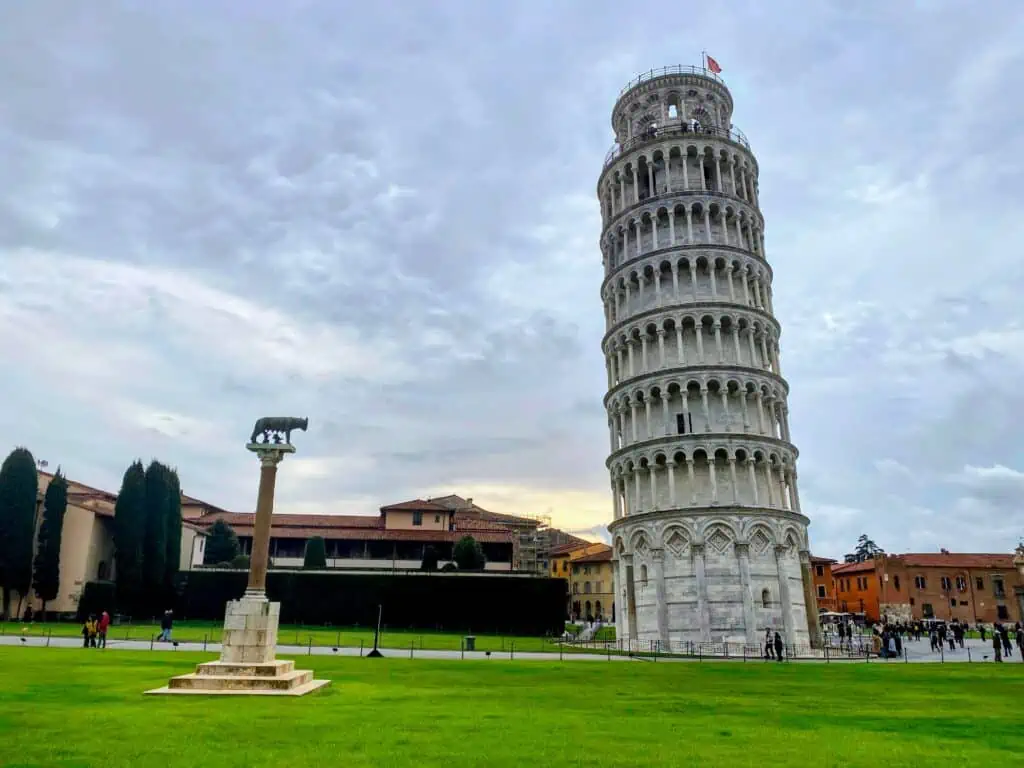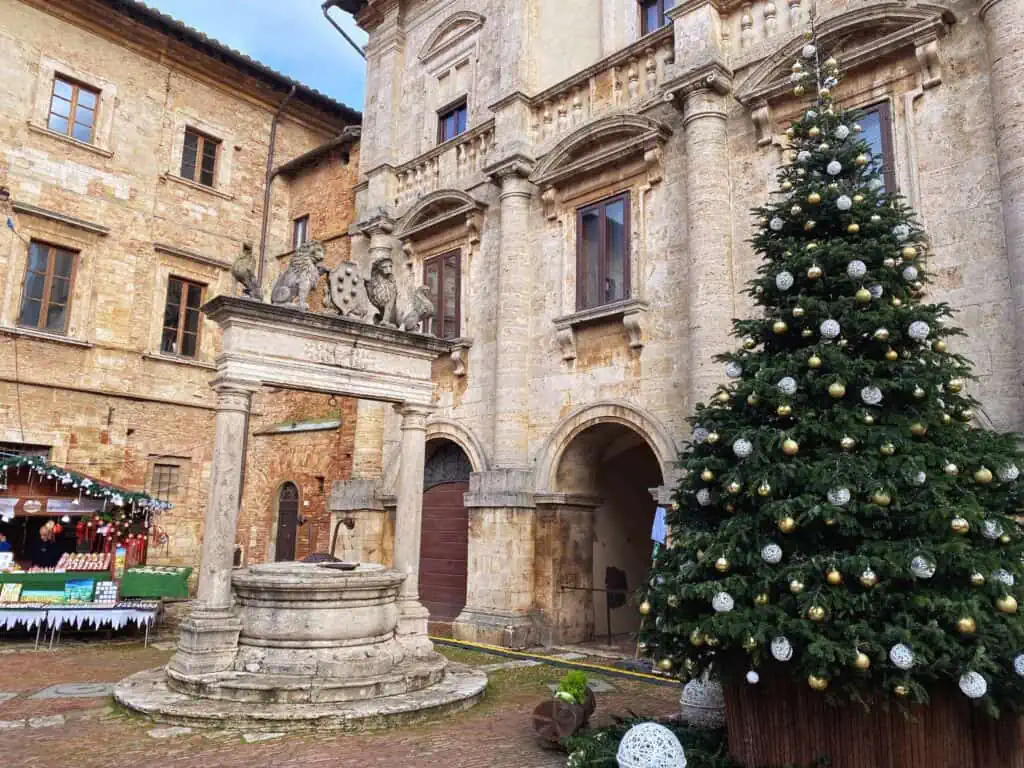Are you looking for some facts about the Leaning Tower of Pisa for your school report?
Or maybe you’re on your way to visit the Leaning Tower of Pisa (to take a silly photo or climb to the top) and want to know a little bit more about the Tower.
Either way, let’s take a look at 23 fun and interesting facts about the Leaning Tower, one of Italy’s most famous landmarks. Sources are listed below, so you can count on these facts to be accurate!
Andiamo – let’s go!
Table of Contents
The Leaning Tower of Pisa is in Tuscany
The Leaning Tower of Pisa is in the city of Pisa, which is in the Italian region of Tuscany, in the center of the country. You can see it on the map:
The Leaning Tower of Pisa is Called by Other Names
In addition to ‘The Leaning Tower of Pisa,’ you’ll also hear it called ‘The Tower of Pisa’ or ‘The Leaning Tower.’ In Italian, it’s called ‘La Torre Pendente,’ ‘La Campanile di Pisa,’ or ‘La Torre di Pisa.’
The Pronunciation of Pisa May Surprise You
Pisa isn’t pronounced ‘PEE-sah.’ Instead, the ‘s’ is pronounced ‘z.’ So, Pisa is pronounced ‘PEE-zah.’ Careful, it’s not ‘pizza,’ which is pronounced ‘PEET-zah.’
Listen to the pronunciation of Pisa:
Construction on the Leaning Tower of Pisa Began in 1173

The construction on the Torre Pendente began in 1173 – the Leaning Tower of Pisa turns 850 years old in 2023! Buon compleanno – happy birthday!
The Leaning Tower of Pisa Leans for a Couple of Reasons
The engineers and architects didn’t plan well enough for the soft land in Pisa. Located close to the sea, the land is marshland, which has a soft and not-very-stable surface. Also, the Leaning Tower was only built on a three-meter foundation, which wasn’t deep enough for such a tall, heavy tower.
The Name ‘Pisa’ Means ‘Marshland’ in Greek
The Leaning Tower of Pisa engineers probably should’ve paid closer attention to this when designing the tower and planning its construction!
The Leaning Tower of Pisa Weighs 14,500 Tons
That means the Leaning Tower of Pisa weighs as much as over 2,000 large African elephants! 1 ton = 2000 lbs.
The Leaning Tower of Pisa is a Bell Tower
Many people believe that the Leaning Tower of Pisa was built for defense purposes. Instead, the Tower is the Bell Tower of the Duomo of Pisa (Pisa Cathedral). If you climb to the top, you’ll see the seven large bells.
The Leaning Tower’s Bells No Longer Ring
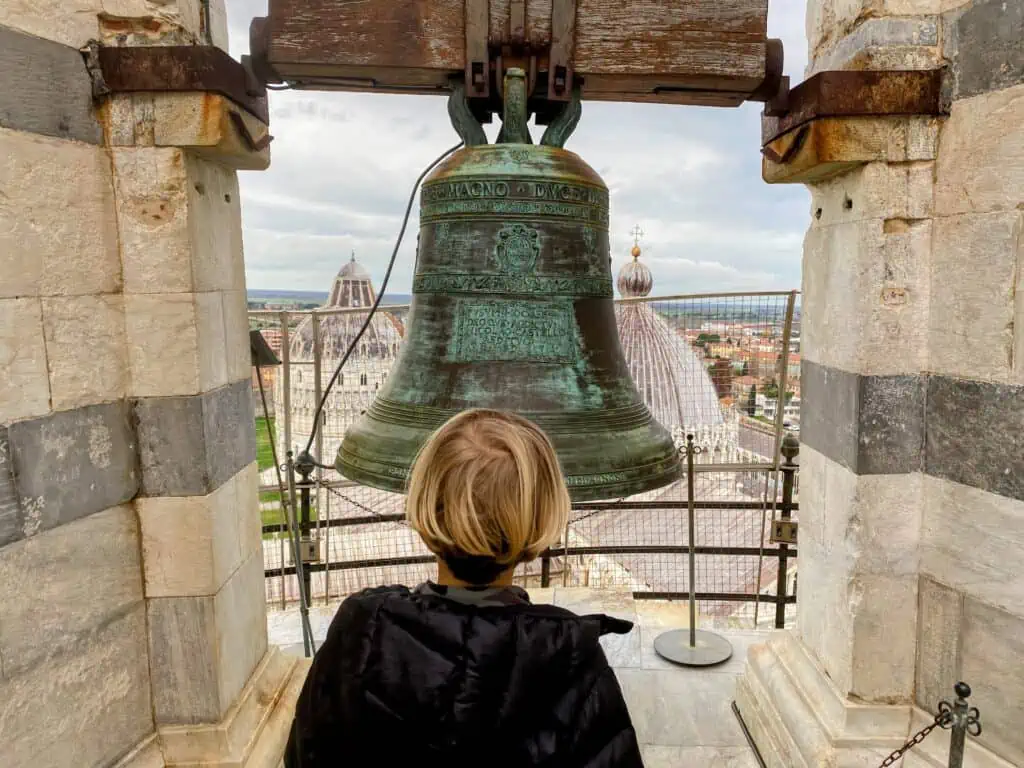
The bells are still located at the top of the Leaning Tower of Pisa, but due to the unstable structure, and fear the bells’ vibrations could affect it, the bells no longer ring.
The Largest Bell of the Torre Pendente Weighs 3.5 Tons
The seven bells make up the seven notes of the musical scale. They include:
- L’Assunta – 7980 lbs
- Crocifisso – 5427 lbs
- San Ranieri – 3192 lbs
- La Terza – 661 lbs
- La Pasquereccia / La Giustizia – 2235 lbs
- Il Vespruccio – 2204 lbs
- Dal Pozzo – 1437 lbs
The Leaning Tower of Pisa’s Height is 58.36 Meters

This is the Torre’s height on its ‘high’ side in 2023, and keep in mind that the height changes over time as the Leaning Tower leans further or recorrects its lean.
The Leaning Tower of Pisa has 8 Stories
The seven bells are on the 8th floor, and you can climb up to see them (and the incredible view of Pisa and beyond).
There are 273 Steps to the Top of the Leaning Tower of Pisa
The steps are on the inside part of the Leaning Tower of Pisa. They are white marble and can be slippery!
The Leaning Tower of Pisa is Leaning at 5.115°
Scientists believe the Tower will collapse when it reaches a lean of 5.44°. However, amazingly, it once leaned at 5.5° and didn’t fall over!
The Leaning Tower of Pisa Leaned During Construction
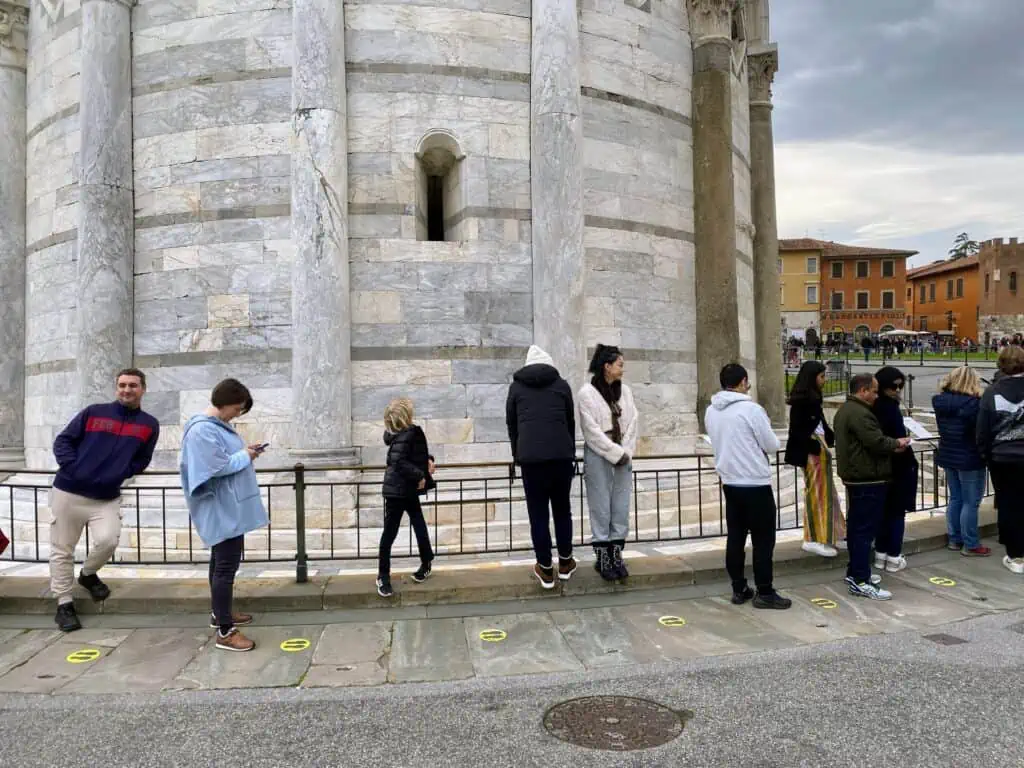
The ‘lean’ in the tower isn’t a modern problem. In fact, the Leaning Tower of Pisa was sinking and leaning even after just a few levels of construction!
In order to correct the tilt, the engineers made the walls on the side of the lean taller for a few levels, resulting in a slight curve in the tower.
War May Have Saved the Leaning Tower of Pisa
War raged during construction of the Leaning Tower, and at one point, construction halted for almost 100 years. Scientists believe this delay helped save the tower because it allowed the ground underneath to settle. The Leaning Tower was finally completed in 1372.
Mussolini Wasn’t Happy with the Leaning Tower of Pisa
Benito Mussolini wanted it fixed! But his engineers made it lean even more and almost toppled it. They drilled holes into the ground around the tower and poured cement inside.
Galileo Used the Leaning Tower of Pisa for Experiments
Galileo Galilei was a professor of mathematics at the University of Pisa in the late 16th century. Legend says that he decided to test his theories on gravity at the Leaning Tower of Pisa. He dropped two balls of equal size (but different masses) from the Leaning Tower to show that they’d land at the same time, regardless of their difference in mass.
The Leaning Tower of Pisa is a UNESCO World Heritage Site
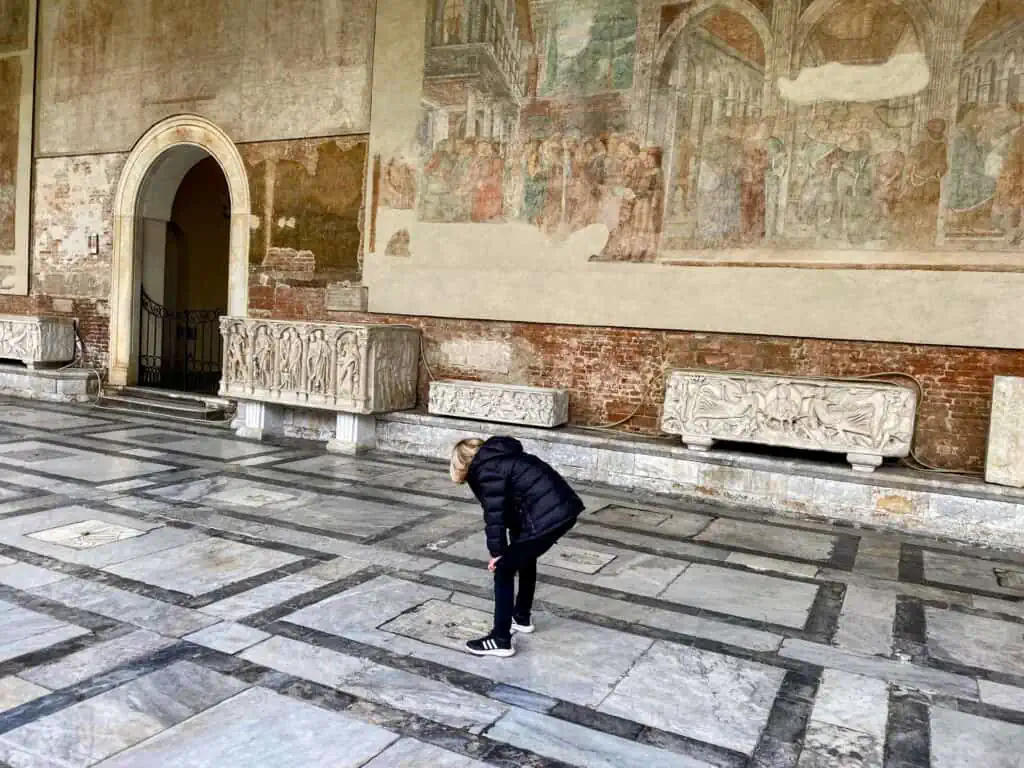
The Piazza del Duomo entered the list of UNESCO World Heritage Sites in 1987. The monuments of the Piazza del Duomo include the Leaning Tower of Pisa (the campanile), the cathedral, the baptistery, and the cemetery (the camposanto).
The Tower Was Closed for 11 Years to Try to Correct Some of the Lean
That 5.5° over-the-limit lean was in the 90s. It’s the most it’s ever leaned, and many believed the Leaning Tower was close to collapse.
So, the tower was closed and engineers worked hard to fix it. They first used steel cables to stabilize it, which involved drilling into the ground. Unfortunately, the marshy land filled the holes with water, so the engineers froze it with liquid nitrogen. But, when the frozen water melted, the tower sunk and leaned even more! To help fix the lean, they then drilled underneath the side opposite the lean, which helped alleviate some of the lean. The total cost of the 11-year project was $27 million.
The Center of Mass Plays an Important Role in the Leaning Tower’s Future
Why hasn’t the Leaning Tower of Pisa collapsed? As long as the center of mass (estimated to be on the 4th floor) sits above the base of the tower and not outside of it, the Tower will remain standing. If that center of mass creeps out of the circumference of the base of the Tower, it will fall down.
You Can Feel the Lean When You’re Climbing the Tower
Not only can you feel the slight lean as you walk the spiral stairs up the edges of the Leaning Tower – you can also see how the steps are worn in different places, depending which side you’re walking on.
Take a look at the walk down from the top of the Leaning Tower of Pisa to ground level:
The Leaning Tower of Pisa Isn’t the Only Leaning Tower in Town
There are other Leaning Towers in Pisa! The bell tower of the Church of San Nicola and the bell tower of the Church of San Michele degli Scalzi are both leaning too!
I hope you’ve enjoyed these facts about the Leaning Tower of Pisa!
If you find yourself in Pisa, be sure to check out
Leaning Tower of Pisa with Kids
Top Things to Do in Pisa
Visiting Pisa with Kids
Leaning Tower of Pisa – Tips For Your Visit
Leaning Tower of Pisa Facts FAQ
Check the official Leaning Tower of Pisa website (see below) to find the most up-to-date data on the lean of the tower.
No, but Giovanni Pisano played an important role in the building of Pisa’s cathedral – he worked on the façade.
Yes, the Leaning Tower of Pisa is part of the Campo dei Miracoli (aka Piazza dei Miracoli), along with the cathedral, baptistery, and cemetery.
No, the Leaning Tower of Pisa is a freestanding bell tower. It sits near the cathedral.
Sources:
Discovery UK – The Leaning Tower of Pisa: Italy’s Legendary Architectural Mistake
TED-Ed – Why Doesn’t the Leaning Tower of Pisa Fall Over?
History Channel – Leaning Tower of Pisa Reopens
Exibart – La Torre di Pisa Pende Sempre di Meno ma Non Si Vede: Uno Studio lo Rivela
Leaning Tower of Pisa Official Website – Opera della Primaziale Pisana
UNESCO – Piazza del Duomo, Pisa
National Geographic – Will the Leaning Tower of Pisa Ever Fall?
7Wonders.org – Leaning Tower of Pisa
Brittanica – Giovanni Pisano
